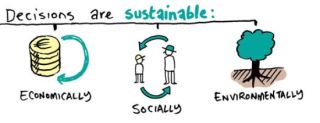Renewable Economies – The potential for circular and bio-economies in Ireland

The shift to a circular economy is labour intensive, focussing on repair, recycling, research and development, regenerating natural capital, and preserving and enhancing land, oceans, forests and wetlands. The business case to move towards a circular economy and decouple economic growth from resource consumption has been outlined by McKinsey in 2014[1] which shows that such a move could add $1 trillion dollars to the global economy by 2025 and that the EU manufacturing sector could generate savings of up to $360 billion per annum by 2025. A wider benefit of the circular economy is the reduction in carbon dioxide emissions.
In December 2015 the European Commission published an action plan which describes the circular economy as ‘where the value of products, materials and resources is maintained in the economy for as long as possible, and the generation of waste minimised’ (European Commission, 2015:2). This action plan is essential to the European Union’s efforts to develop a sustainable, low carbon, and resource efficient economy. It is explicitly linked to the EU’s SDG commitments.
The 2018 Circular Economy Package includes a Europe-wide Strategy for Plastics in the Circular Economy; a communication on options to address the interface between chemical, product and waste legislation; a Monitoring Framework on progress towards a circular economy; and a Report on Critical Raw Materials and the circular economy. The Monitoring Framework is particularly instructive in that it ‘puts forward a set of key, meaningful indicators which capture the main elements of the circular economy’. Changing from a linear economy to a circular one presents a challenge across all sectors, but bears rewards from an economic, environmental and social standpoint. The monitoring framework attempts to deal with this systemic challenge through the development of these key indicators which take a cross-sectoral view of progress, grouping the ten indicators into four aspects of the circular economy: production and consumption, waste management, secondary and raw materials, and competitiveness and innovation. The monitoring framework goes on to provide examples of each of the indicators and the EU levers, where possible.
Finland (which ranks 3rd in the Sustainable Progress Index) published their roadmap to a circular economy in 2016 which aims to achieve a circular economy by 2025, concentrating on economic, environmental and social growth and benefits[2]. They will initially concentrate their circular economic growth on five areas: sustainable food systems; forest-based loops; technical loops; transport and logistics; and common action. Were Ireland to adopt this model, it would need the support of the agricultural sector to engage in more sustainable practices in food production to minimise emissions; a concerted effort to increase forestry (and other natural resources); a commitment to R&D that focuses on longevity and sustainable production; greater incentives to use clean fuels in transport; and recognition of the relationships and interconnectivity between the economy, environment and society. Ireland should be at the forefront of rethinking and redeveloping the use of plastics in the global supply chain. An innovative and sustainable plastics industry, where all elements fully respect the circular economy principles would help to create jobs and reduce greenhouse gas emissions.
Ensuring that product design, development and delivery is based on the principles of reusability, reparability and recyclability, and that materials for these products are sourced using sustainable methods, should be at the forefront of any R&D initiatives supported by Government. An expansion of the principles of the Ecodesign Directive (European Council, 2009), which was transposed into Irish law in December 2015 and provides for design specifications for energy products and products on which energy savings could be made, would greatly aid Ireland’s progression of a circular economy.
The concept of ‘cradle to cradle development’ involves reviewing the processes of production to not only minimise waste but eliminate it altogether. Ireland has often been lauded as a hub of innovation. Our environment, and consequently our economy and society, would benefit greatly from the adoption of ‘cradle to cradle’ design principles .
It is important that Ireland now moves to embrace the circular economy and to implement the monitoring framework provided in 2018 Circular Economy Package. A reduction in waste and consumption will help prevent waste of our finite natural resources and aid Ireland in meeting environmental targets. It will also positively impact our economy by eliminating harmful subsidies and implementing more of the ‘polluter pays’ principle.
Mitigation and Transition - supporting communities and people
The Department’s paper is a good start, however a comprehensive mitigation and transition strategy is required to ensure there is public support for our domestic and international environmental and sustainable development goals. This strategy must pre-empt some of the challenges we face as we move to a more sustainable form of development. Social Justice Ireland proposes that the strategy should contain as a minimum:
- retraining and support for those communities who will be most impacted by the loss of employment related to the move away from fossil fuels;
- support and investment in the circular economy with regional strategies and targets;
- investment in the deep retrofitting of homes and community facilities;
- investment in community energy advisors and community energy programmes;
- investment in renewable energy schemes;
- policies to eliminate energy poverty;
- investment in a quality, accessible and well-connected public transport network.
The development of a national mitigation and transition strategy is a matter of priority if there is to be public support for the significant and fundamental changes required in the years ahead.
[1] McKinsey Global Institute (2011) Resource revolution: Meeting the world’s energy, materials, food, and water needs. London: McKinsey Global Institute.
[2] Sitra (2016): Leading the Cycle: Finnish road map to a circular economy 2016-2025. Helsinki: Sitra